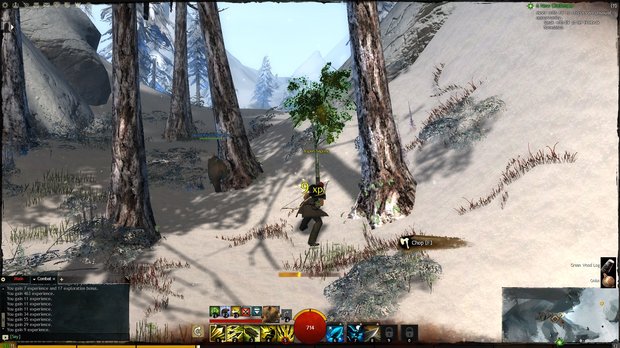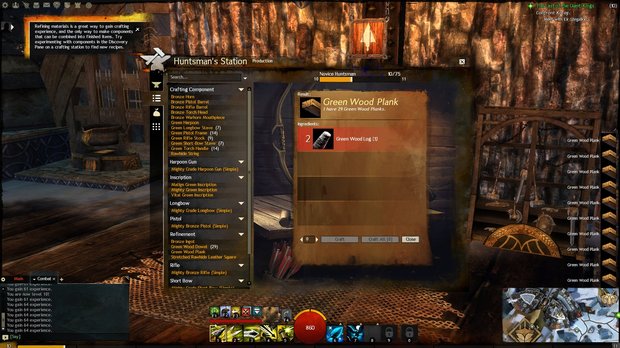Guild Wars 2 crafting guide
Time to hone some new skills
As in almost any MMO, Guild Wars 2 has a robust crafting system that will let you gather materials and craft a wide variety of items, both for personal use and to sell to other players. There are a fair amount of intricacies to the system, so we won't go into mind-numbing detail here, but if you want a basic introduction, this ought to get you started on your path towards becoming a master craftsman.
No Gathering Skills
First off, there aren't any gathering professions in Guild Wars 2, so you won't have to use any of your . You'll collect crafting materials by purchasing sickles, axes, and picks from a merchant that sells them (there should be one near where you first pop into the game world, or near the craftsman section of any capital city). Buy some rudimentary gathering tools as early as you can afford them, and equip them by double-clicking on them in your inventory. This will let you gather any ore veins, wood, or plants that you see in the game world; all of these will be marked on your mini-map as you travel, and multiple players can collect from the same collection item, so don't worry too much about collection. Just gather as you adventure, and you'll soon find plenty of items to craft with. (And be sure to use the Options - Deposit All Collectibles tool to send all those items directly to your bank when your bags get full!) These gathering tools will break down over time, so you may wish to bring spares with you when you head out for a long trip.

Another source of crafting materials comes from salvaging. The same merchants who sold you your tools will sell you salvaging kits, which you can use on many items in your inventory (especially armor and weapons you don't need or can't use) to break them down into their constituent parts. Higher-quality salvaging kits will net you a better chance of getting rare materials from the items you break down, so it's worth paying for the higher-quality kits as they become available.
The Crafting Basics
When you have a fair amount of crafting materials in your bank, it's time to go learn a trade. Here's a list of the available crafting skills:
Huntsman: Creates ranged weapons, mostly intended for rangers and engineers. Pistols, rifles, and bows are largely what you'll be focusing on as a huntsman.
Weaponsmith: Most melee weapons will come from this craft, including daggers, hammers, axes, shields, and swords.
Tailor: Creates light armor for spellcasting classes, as well as cloth bags.
Leatherworker: Creates medium armor, as well as leather bags.
Armorsmith: Creates heavy armor, as well as inventory boxes. (Note that all of the craftable bags/boxes are effectively the same.)
Jeweler: Creates necklaces, earrings, rings, and other accessories. Relies on the collection of gemstones, which can be found largely through mining, but also sometimes through collecting wood. Can make items wearable by any class, so a decent choice if you can't decide what you want to make!
Chef: Creates consumable items that can be eaten for a short-term boost of some sort, whether to an attribute, experience gain, chance to find magical gear, and so on. Can also create armor dyes.
In most cases, you'll want to take the armor and weapon crafting skills that correspond to your class's equipment, but you can feel free to dip into jeweling or baking if you like. Note that the chef skill, while useful, is also going to be the most expensive craft to dip into, as it requires a fair amount of ingredients from a wide array of places. Cook if you like, but be aware that you'll be paying for it! You may wish to go through a few different characters and gather as many plants as you can before dipping into cooking, just to make it easier to get through the early levels of the profession.
How To Craft
In the home city for your race (or any race), you should be able to find a collection of crafting trainers nestled together somewhere. When you decide you want to learn a trade, head there and talk to the master craftsman standing near their station to pick up the relevant crafting ability, then head over to the nearby crafting station to see what you can make. (If you've been using the Deposit All Collectibles button, you'll need to move all of the items from your Collections into your bags in order to use them in recipes.) Even when you're first starting out on a profession, you should have plenty of items available to you to craft, assuming you have the proper materials.

Many of the crafting professions will ask you to take the raw materials that you've been gathering and refine them somehow before you can actually use them in recipes. For example, if you want to use wood in Huntsman recipes, you'll need to transform all of your Green Wood Logs from Amber Saplings into Green Wood Planks, which you can then use to make the items that you need to combine into a Crude Short Bow, and so on. Generally, you'll want to click on the items that you want to craft, then work backwards from its ingredients until you discover how to make them all. Some recipes will require unfamiliar items Lumps of Tin or bolts of thread; check with your trainer to see if they sell those.
When you have the ingredients together for the item you wish to craft, go ahead and make it! Much of the equipment that you can make will have a new recipe with more damage and defense every five levels or so. Of course, you'll need to learn new recipes to do so. How to do that, though?
Recipe Discovery, Experimentation, And Purchasing
If you want to proceed in your chosen trade, you'll need to bang your head a bit against GW2's "discovery" mechanism. You'll find it at the top of your crafting station's options, in the shape of an anvil. When you get a few items under your belt, head here to learn new recipes and experiment a bit.
The discover panel will have four slots for you to drag ingredients into, with a selection of possible ingredients on the left side of the window. You can feel free to fool around with the ingredients you have available to you (and it's well worth doing so, just to see what happens, especially since you can't waste any ingredients since the game won't let you proceed until you have something to craft), but here's a tip to get you started. Most crafting professions have some kind of "insignia" that's used to determine the kind of weapon or armor that results from a recipe. You can combine these insignia with the basic crafting recipe for an item in the discovery panel to create a new kind of item, and learn a new recipe to boot.
For instance, if you learn leatherworking, the only boots you can initially make are the Mighty Seeker's Boots (Simple), which have a mediocre +2 Power attribute for them. They require 1 Vial of Weak Blood, a Rawhide Boot Upper, and a Rawhide Boot Sole to craft. However, if you wanted to make a pair of boots with +Vitality instead, you could first craft a Vital Jute Insignia, take that to the discovery panel, and combine it with the Rawhide Boot Upper and the Rawhide Boot Sole to make a set of Vital Seeker's Boots. So, when you want to learn new recipes, try experimenting with the ingredients you already have to recipes that you already know, and add different and rare ingredients to them in the discovery pane to try and see what secrets you might uncover.
You can also buy many recipes; your craft trainers will sell many of them in exchange for the karma you've been banking from events.
For more Guild Wars 2 guides, go
You can also buy many recipes; your craft trainers will sell many of them in exchange for the karma you've been banking from events.
For more Guild Wars 2 guides, go
Sign up to the GamesRadar+ Newsletter
Weekly digests, tales from the communities you love, and more


